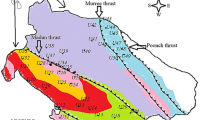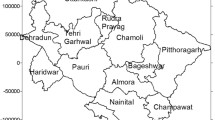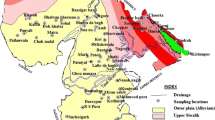Abstract
The main contribution of radiation dose to the human lungs from natural exposure originates from short-lived radon progeny. In the present work, the inhalation doses from indoor short-lived radon progeny, i.e., 218Po, 214Pb, 214Bi, and 214Po, to different age groups of members of the public were calculated. In the calculations, the age-dependent systemic biokinetic models of polonium, bismuth, and lead published by the International Commission on Radiological Protection (ICRP) were adopted. In addition, the ICRP human respiratory tract and gastrointestinal tract models were applied to determine the deposition fractions in different regions of the lungs during inhalation and exhalation, and the absorption fractions of radon progeny in the alimentary tract. Based on the calculated contribution of each progeny to equivalent dose and effective dose, the dose conversion factor was estimated, taking into account the unattached fraction of aerosols, attached aerosols in the nucleation, accumulation and coarse modes, and the potential alpha energy concentration fraction in indoor air. It turned out that for each progeny, the equivalent doses to extrathoracic airways and the lungs are greater than those to other organs. The contribution of 214Po to effective dose is much smaller compared to that of the other short-lived radon progeny and can thus be neglected in the dose assessment. In fact, 90 % of the effective dose from short-lived radon progeny arises from 214Pb and 214Bi, while the rest is from 218Po. The dose conversion factors obtained in the present study are 17 and 18 mSv per working level month (WLM) for adult female and male, respectively. This compares to values ranging from 6 to 20 mSv WLM−1 calculated by other investigators. The dose coefficients of each radon progeny calculated in the present study can be used to estimate the radiation doses for the population, especially for small children and women, in specific regions of the world exposed to radon progeny by measuring their concentrations, aerosol sizes, and unattached fractions.



Similar content being viewed by others
References
Al-Jundi J, Li WB, Abusini M, Tschiersch J, Hoeschen C, Oeh U (2011) Inhalation dose assessment of indoor radon progeny using biokinetic and dosimetric modeling and its application to Jordanian population. J Environ Radioact 102:574–580
Barrett PHR, Bell BM, Cobelli C, Golde H, Schumitzky A, Vicini P, Foster DM (1998) SAAM II: simulation, analysis, and modeling software for tracer and pharmacokinetic studies. Metabolism 47:484–492
Bi L, Li WB, Tschiersch J, Li JL (2010) Age and sex dependent inhalation doses to members of the public from indoor thoron progeny. J Radioact Prot 30:639–658
Birchall A, James AC (1994) Uncertainty analysis of the effective dose per unit exposure from radon progeny and implications for ICRP risk-weighting factors. Radiat Prot Dosim 53:133–140
Bolch WE, Eckerman KF, Sgouros G, Thomas SR (2009) MIRD pamphlet no. 21: a generalized schema for radiopharmaceutical dosimetry-standardization of nomenclature. J Nucl Med 50(3):477–484
Booker DV, Chamberlain AC, Newton D, Scott AN (1969) Uptake of radioactive lead following inhalation and injection. Br J Radiol 42:457–466
Darby S, Hill D, Auvinen A, Barros-Dios JM, Baysson H, Bochicchio F, Deo H, Falk R, Forastiere F, Hakama M, Heid I, Kreienbrock L, Kreuzer M, Lagarde F, Mäkeläinen I, Muirhead C, Oberaigner W, Pershagen G, Ruano-Ravina A, Ruosteenoja E, Rosario AS, Tirmarche M, Tomásek L, Whitley E, Wichmann HE, Doll R (2005) Radon in homes and risk of lung cancer: collaborative analysis of individual data from 13 European case-control studies. Br Med J 330:223–226
Darby S, Hill D, Deo H, Auvinen A, Barros-Dios JM, Baysson H, Bochicchio F, Falk R, Farchi S, Figueiras A, Hakama M, Heid I, Hunter N, Kreienbrock L, Kreuzer M, Lagarde F, Mäkeläinen I, Muirhead C, Oberaigner W, Pershagen G, Ruosteenoja E, Rosario AS, Tirmarche M, Tomásek L, Whitley E, Wichmann HE, Doll R (2006) Residential radon and lung cancer: detailed results of a collaborative analysis of individual data on 7148 subjects with lung cancer and 14208 subjects without lung cancer from 13 epidemiologic studies in Europe. Scand J Work Environ Health 32(Suppl 1):1–83
Firestone RB (1996) Table of isotopes, 8th CD-ROM edn. Wiley, New York
Hursh JB, Mercer TT (1970) Measurement of 212Pb loss rate from human lungs. J Appl Physiol 28:268–274
Hursh JB, Schraub A, Sattler EL, Hofmann HP (1969) Fate of 212Pb inhaled by human subjects. Health Phys 16:257–267
ICRP (1979) Limits for intakes of radionuclides by workers. Part 1. ICRP Publication 30. Ann. ICRP 2(3–4). Pergamon, Oxford
ICRP (1980) Limits for intakes of radionuclides by workers. Part 2. ICRP Publication 30. Ann ICRP 4 (3-4). Pergamon, Oxford
ICRP (1987) Lung cancer risk from indoor exposure radon daughters ICRP Publication 50. Ann ICRP 17(1). Pergamon, Oxford
ICRP (1989) Age-dependent doses to members of the public from intake of radionuclides: Part 1. ICRP Publication 56. Ann ICRP 20(2). Pergamon, Oxford
ICRP (1991) 1990 recommendations of the International Commission on Radiological Protection. ICRP Publication 60. Ann ICRP 21(1–3). Pergamon, Oxford
ICRP (1993a) Age-dependent doses to members of the public from intake of radionuclides: Part 2. Ingestion dose coefficients. ICRP Publication 67. Ann ICRP 23(3–4). Pergamon, Oxford
ICRP (1993b) Protection against Radon-222 at home and at work. ICRP Publication 65. Ann ICRP 23(2). Pergamon, Oxford
ICRP (1994) The human respiratory tract model for radiological protection. ICRP Publication 66. Ann ICRP 24(1–3). Pergamon, Oxford
ICRP (1995) Age-dependent doses to members of the public from intake of radionuclides: Part 4. Inhalation dose coefficients. ICRP Publication 71. Ann ICRP 25(3–4). Pergamon, Oxford
ICRP (2002) Guide for the practical application of the ICRP human respiratory tract model. ICRP Supporting Guidance 3. Pergamon, Oxford
ICRP (2006) Human alimentary tract model for radiological protection. ICRP Publication 100. Ann ICRP 36(1–2). Pergamon, Oxford
ICRP (2007) The 2007 recommendations of the International Commission on Radiological Protection. ICRP Publication 103. Ann ICRP 37(2–4). Pergamon, Oxford
ICRP (2008) Nuclear decay data for dosimetric calculations. ICRP Publication 107. Ann ICRP 38(3). Elsevier Ltd, Oxford
ICRP (2010) Lung cancer risk from radon and progeny and statement on radon. ICRP Publication 115. Ann ICRP 40(1). Elsevier Ltd, Oxford
Jacobi W (1964) The dose to the human respiratory tract by inhalation of short-lived 222Rn- and 220Rn-decay products. Health Phys 10:1163–1174
Jacobi W, Eisfeld K (1980) Dose to tissues and effective dose equivalent by inhalation of Radon-222, Radon-220 and their short-lived daughters. GSF Report S-626, GSF—Research Center for Environment and Health, Neuherburg
James AC, Birchall A, Akabani G (2004) Comparative dosimetry of BEIR VI revisited. Radiat Prot Dosim 108:3–26
Kendall GM, Smith TJ (2002) Doses to organs and tissues from radon and its decay. J Radiol Prot 22:389–406
Kendall GM, Smith TJ (2005) Doses from radon and its decay products to children. J Radiol Prot 25:241–256
Krewski D, Lubin JH, Zielinski JM, Alavanja M, Catalan VS, Field RW, Klotz JB, Létourneau EG, Lynch CF, Lyon JL, Sandler DP, Schoenberg JB, Steck DJ, Stolwijk JA, Weinberg C, Wilcox HB (2005) Residential radon and risk of lung cancer: a combined analysis of 7 North American case-control studies. Epidemiology 16(2):137–145
Krewski D, Lubin JH, Zielinski JM, Alavanja M, Catalan VS, Field RW, Klotz JB, Létourneau EG, Lynch CF, Lyon JL, Sandler DP, Schoenberg JB, Steck DJ, Stolwijk JA, Weinberg C, Wilcox HB (2006) A combined analysis of North American case-control studies of residential radon and lung cancer. J Toxicol Environ Health A 69:533–597
Lau BMF, Nikezic D, Yu KN (2006) Killing of target cells due to radon progeny in the human lung. Radiat Prot Dosim 122(1–4):534–536
Li WB, Roth P, Wahl W, Oeh U, Hollrigel V, Paretzke HG (2005) Biokinetic modeling of uranium in man after injection and ingestion. Radiat Environ Biophys 44:29–40
Li WB, Tschiersch J, Oeh U, Hoeschen C (2008a) Lung dosimetry of inhaled thoron decay products. In: IRPA 12 proceeding, Buenos Aires Argentina 19–24 October 2008. CD-ROM, pp 1–10. http://www.irpa12.org.ar/fullpapers/FP0823.pdf
Li WB, Gerstmann UC, Höllriegl V, Szymczak W, Roth P, Hoeschen C, Oeh U (2008b) Radiation dose assessment of exposure to depleted uranium. J Expo Sci Environ Epidemiol 19(5):502–514
Li WB, Greiter M, Oeh U, Hoeschen C (2011a) Reliability of a new biokinetic model of zirconium in internal dosimetry: part I, parameter uncertainty analysis. Health Phys 101:660–676
Li WB, Greiter M, Oeh U, Hoeschen C (2011b) Reliability of a new biokinetic model of zirconium in internal dosimetry: part II, parameter sensitivity analysis. Health Phys 101:677–692
Li WB, Klein W, Blanchardon E, Puncher M, Leggett RW, Oeh U, Breustedt B, Noßke D, Lopez MA (2014) Parameter uncertainty analysis of a biokinetic model of caesium. Radiat Prot Dosim. doi:10.1093/rpd/ncu055
Lubin JH, Wang ZY, Boice JD, Xu ZY, Blot WJ, Wang LD, Kleinerman RA (2004) Risk of lung cancer and residential radon in China: pooled results of two studies. Int J Cancer 109:132–137
Lubin JH, Wang ZY, Wang LD, Boice JD Jr, Cui HX, Zhang SR, Conrath S, Xia Y, Shang B, Cao JS, Kleinerman RA (2005) Adjusting lung cancer risks for temporal and spatial variations in radon concentration in dwellings in Gansu Province, China. Radiat Res 163:571–579
Marsh JW, Birchall A (1999) Determination of lung-to-blood absorption rates for lead and bismuth that are appropriate for radon progeny. Radiat Prot Dosim 83:331–337
Marsh JW, Birchall A (2000) Sensitivity analysis of the weighted equivalent lung dose per unit exposure from radon progeny. Radiat Prot Dosim 87:167–178
Marsh JW, Birchall A, Butterweck G, Dorrian MD, Huet C, Reineking G, Tymen G, Schulert CH, Vargas A, Vezzu G, Wendt J (2002) Uncertainty analysis of the weighted equivalent lung dose per unit exposure to radon progeny in the home. Radiat Prot Dosim 102(3):229–248
Marsh JW, Birchall A, Davis K (2005) Comparative dosimetry in homes and mines: estimation of K-factors. Radioact Environ 7:290–298
Marsh JW, Harrison JD, Laurier D, Blanchardon E, Paquet F, Tirmarche M (2010) Dose conversion factors for radon: recent developments. Health Phys 99:511–516
Mohamed A (2005) Study on radon and radon progeny in some living rooms. Radiat Prot Dosim 117:402–407
Nikezic D, Lau BMF, Stevanovic N, Yu KN (2006) Absorbed dose in target cell nuclei and dose conversion coefficient of radon progeny in the human lung. J Environ Radioact 89:18–29
Pillai PM, Paul AC, Bhat IS, Iyer MR, Pillai KC (1994) Deposition and clearance of 212Pb in humans. Health Phys 66(3):343–345
Porstendörfer J (1994) Properties and behaviour of radon and thoron and their decay products in the air. J Aerosol Sci 25(2):219–263
Porstendörfer J (2001) Physical parameters and dose factors of the radon and thoron decay products. Radiat Prot Dosim 94(4):365–373
TGLD (Task Group on Lung Dynamics) (1966) Deposition and retention models for internal dosimetry of the human respiratory tract. Health Phys 12:173–207
UNSCEAR (2000) UNSCEAR 2000 Report. Sources and effects of ionizing radiation. Report to the General Assembly with Scientific Annexes. United Nations, New York
UNSCEAR (2008) UNSCEAR 2006 Report. Effects of ionizing radiation. In: Annex E sources-to-effects assessment for radon in homes and workplaces, Vol. II. United Nations, New York
Weibel ER (1963) Morphometry of the human lung. Springer, Berlin
WHO (2009) WHO handbook on indoor radon: a public health perspective. World Health Organization, Geneva
Yu KN, Cheung TTK, Haque AKMM, Nikezic D, Lau BMF, Vucic D (2001a) Radon progeny dose conversion coefficients for Chinese males and females. J Environ Radioact 56:327–340
Yu KN, Wong BTY, Law JYP, Lau BMF, Nikezic D (2001b) Indoor dose conversion coefficients for radon progeny for different ambient environments. Environ Sci Technol 35:2136–2140
Zhang ZG, Smith B, Steck DJ, Guo Q, Field RW (2007) Variation in yearly residential radon concentrations in the upper midwest. Health Phys 93:288–297
Acknowledgments
This work was supported by the German Federal Ministry of Education and Research (BMBF) with the contract number 02NUK015B. The contents are solely the responsibility of the authors.
Author information
Authors and Affiliations
Corresponding authors
Electronic supplementary material
Below is the link to the electronic supplementary material.
Appendices
Appendix 1: Age-dependent dose coefficients for members of the public exposed to short-lived radon progeny
Age-dependent dose coefficients (Sv Bq−1) for members of the public exposed to short-lived radon progeny, i.e., 218Po, 214Pb, 214Bi, and 214Po, both for the unattached mode (1 nm) and for progeny in the nucleation (50 nm), accumulation (230 nm) and coarse (2,500 nm) modes are presented in Tables A1–A16 (see supplementary electronic material).
Appendix 2: Calculation of the radon dose conversion factor (DCF) from individual dose coefficients of progeny
This appendix illustrates the derivation of Eq. (4) from dose coefficients into two different units, i.e., in the unit of Sv (J m−3 h)−1 and Sv WLM−1, so that the DCFs given in different units can be easily converted. In the calculation of DCFs, the following steps were performed:
-
1.
The dose coefficients per potential alpha energy were calculated;
-
2.
The contribution of each progeny to the potential alpha energy was calculated, according to the ratios of concentrations of the nuclides and the particle sizes;
-
3.
The dose contribution per exposure of each progeny in each size was calculated;
-
4.
All the contributions were added.
Furthermore, the ratio of the activity concentrations in the air (C j,i in Bq m−3) and the ratio of the four aerosol sizes (unattached to coarse; f pj ) are given in Table 1.
The dose coefficients (Sv Bq−1) are summarized in Table 10.
For a convenient application in practice, the dose conversion factors of radon progeny are calculated in the units of Sv (J m−3 h)−1 and Sv WLM−1 (Table 11) where 1 WL = 2.08 × 10−5 J m−3 and 1 WLM = 2.08 × 10−5 J m−3×170 h = 3.54 × 10−3 J m−3 h.
Rights and permissions
About this article
Cite this article
Brudecki, K., Li, W.B., Meisenberg, O. et al. Age-dependent inhalation doses to members of the public from indoor short-lived radon progeny. Radiat Environ Biophys 53, 535–549 (2014). https://doi.org/10.1007/s00411-014-0543-8
Received:
Accepted:
Published:
Issue Date:
DOI: https://doi.org/10.1007/s00411-014-0543-8




